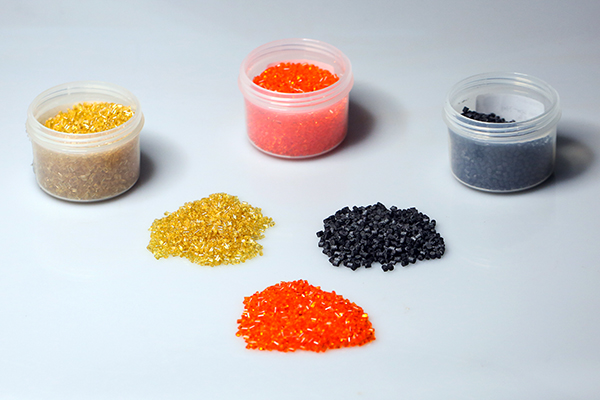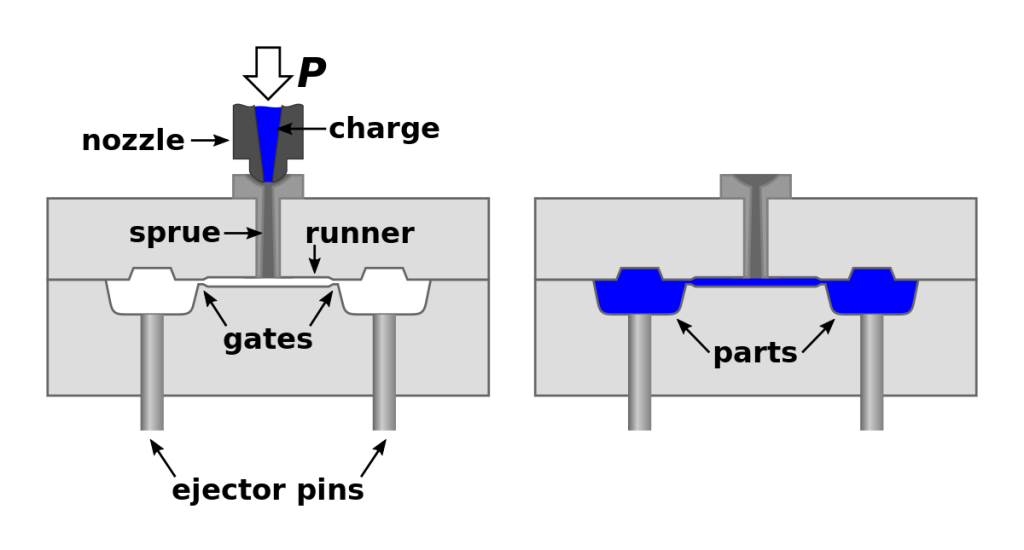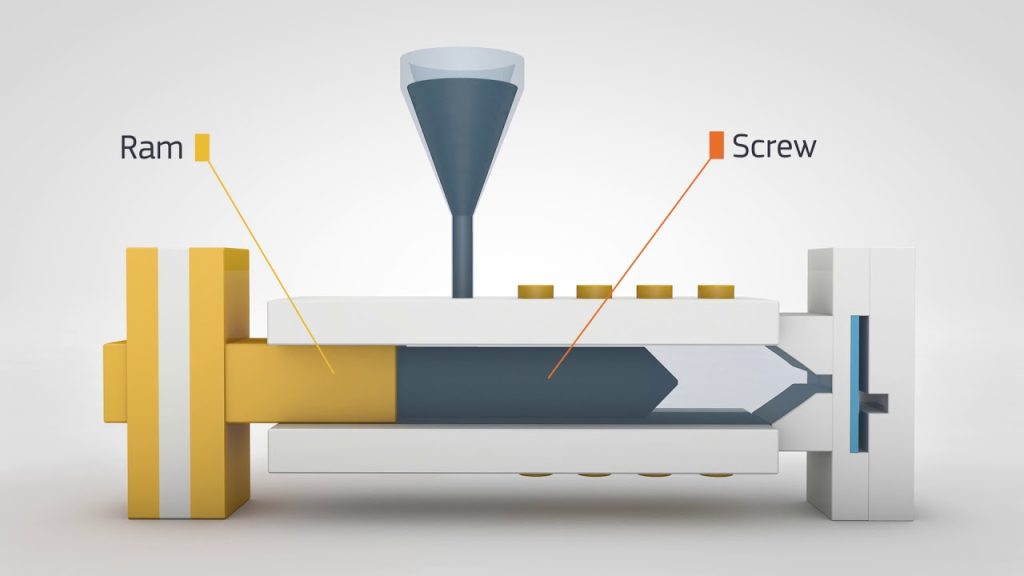Table of Contents
- What Type of Plastic is Used in Injection Molding?
- Frequently Asked Questions
- What are the different types of plastic used in injection molding?
- How do you choose the right type of plastic for injection molding?
- What is the most commonly used plastic in injection molding?
- Can recycled plastic be used in injection molding?
- What are the advantages of using plastic in injection molding?
Plastic injection molding is one of the most popular manufacturing processes used to produce plastic parts. It involves injecting molten plastic into a mold cavity to create a solid object. But have you ever wondered what type of plastic is used in injection molding? In this article, we’ll explore the different types of plastic used in injection molding and their unique properties.
From high-density polyethylene (HDPE) to polycarbonate (PC), each plastic has its own set of advantages and disadvantages. Understanding the differences between these plastics is essential for creating high-quality, durable products. So, whether you’re a seasoned manufacturing professional or just curious about the process, keep reading to learn more about the world of plastic injection molding.
Injection molding involves melting plastic pellets and injecting them into a mold to create a part or product. The most commonly used plastics in injection molding are polystyrene, polyethylene, polypropylene, and acrylonitrile-butadiene-styrene (ABS). Each plastic has its own unique properties, making it suitable for different applications. Polystyrene, for example, is lightweight and used for disposable products, while ABS is stronger and used for products that require durability.
What Type of Plastic is Used in Injection Molding?
In the manufacturing industry, injection molding is a popular method for creating plastic parts in large quantities. The process involves heating plastic materials to a molten state and injecting them into a mold, where they cool and harden into the desired shape. But what type of plastic is used in injection molding? In this article, we’ll explore the different types of plastic commonly used in injection molding and their unique properties.
Polypropylene (PP)
Polypropylene (PP) is a versatile thermoplastic that is widely used in injection molding. It has a low density, which makes it lightweight and easy to mold. PP is also resistant to heat, chemicals, and fatigue, making it ideal for a range of applications, including packaging, automotive parts, and consumer goods.
PP is also recyclable, making it an environmentally friendly option for manufacturers. It can be easily molded into different shapes and sizes, and it is cost-effective compared to other types of plastics. However, it has a low impact strength and can become brittle in cold temperatures.
Acrylonitrile Butadiene Styrene (ABS)
Acrylonitrile Butadiene Styrene (ABS) is another popular plastic used in injection molding. It is a thermoplastic polymer that is known for its toughness, impact resistance, and heat resistance. ABS is commonly used in the automotive industry for interior and exterior parts, as well as in consumer electronics, toys, and household appliances.
ABS is also easy to mold, making it a cost-effective option for manufacturers. It can be colored and finished in a variety of ways, and it has good dimensional stability. However, ABS is not as chemically resistant as some other plastics, and it can be prone to warping and cracking.
Polycarbonate (PC)
Polycarbonate (PC) is a strong and durable plastic that is commonly used in injection molding. It has a high impact strength, making it ideal for applications that require resistance to impact and shock, such as automotive parts, safety helmets, and electronic components.
PC is also transparent, making it a popular choice for applications that require clarity, such as medical devices and eyewear. It has good heat resistance and can be easily molded into complex shapes. However, PC is relatively expensive compared to other plastics, and it can be prone to scratching and yellowing over time.
Polyethylene (PE)
Polyethylene (PE) is a lightweight and flexible plastic that is commonly used in injection molding. It has a low density, making it an ideal choice for applications that require lightweight and durable parts, such as packaging, toys, and household items.
PE is also resistant to moisture and chemicals, making it ideal for outdoor applications. It can be easily molded into different shapes and sizes, and it is a cost-effective option for manufacturers. However, PE has a low melting point and can be prone to warping and shrinkage during the molding process.
Polyvinyl Chloride (PVC)
Polyvinyl Chloride (PVC) is a versatile plastic that is commonly used in injection molding. It has good mechanical properties, making it ideal for applications that require toughness and durability, such as pipes, fittings, and electrical components.
PVC is also resistant to chemicals, making it ideal for applications that require resistance to harsh environments. It can be easily molded into different shapes and sizes, and it is a cost-effective option for manufacturers. However, PVC can be prone to degradation over time, and it is not suitable for high-temperature applications.
Polyethylene Terephthalate (PET)
Polyethylene Terephthalate (PET) is a strong and lightweight plastic that is commonly used in injection molding. It has good dimensional stability, making it ideal for applications that require precision and accuracy, such as medical devices and electronic components.
PET is also resistant to moisture and chemicals, making it a popular choice for food and beverage packaging. It can be easily molded into different shapes and sizes, and it is a cost-effective option for manufacturers. However, PET can be prone to cracking and yellowing over time, and it is not suitable for high-temperature applications.
Benefits of Injection Molding
Injection molding offers a range of benefits for manufacturers. It allows for the production of high-quality, complex parts in large quantities, with minimal waste and cost. Injection molding also offers design flexibility, allowing for the creation of parts with intricate shapes and features.
Another benefit of injection molding is its efficiency. The process is highly automated, reducing labor costs and increasing productivity. Additionally, injection molding allows for the use of a wide range of materials, including plastics, metals, and ceramics, giving manufacturers the flexibility to choose the best material for their application.
Injection Molding vs. Other Manufacturing Processes
Injection molding has several advantages over other manufacturing processes. For example, it allows for the creation of complex, high-quality parts in large quantities, with minimal waste and cost. Other manufacturing processes, such as CNC machining and 3D printing, may be more suitable for smaller quantities or parts with less complexity.
Injection molding also offers design flexibility, allowing for the creation of parts with intricate shapes and features. Other manufacturing processes may have limitations on the types of parts that can be produced. Additionally, injection molding is highly automated, reducing labor costs and increasing productivity.
Conclusion
In conclusion, injection molding is a popular method for creating plastic parts in large quantities. The type of plastic used in injection molding depends on the specific application and the desired properties of the part. Polypropylene, acrylonitrile butadiene styrene, polycarbonate, polyethylene, and polyvinyl chloride are some of the most commonly used plastics in injection molding.
Each plastic has unique properties and advantages, making it suitable for different applications. Injection molding offers a range of benefits for manufacturers, including efficiency, design flexibility, and the ability to use a wide range of materials. Overall, injection molding is a versatile and cost-effective manufacturing process that has revolutionized the production of plastic parts.
Frequently Asked Questions
Injection molding is a popular manufacturing process that involves melting plastic pellets and injecting them into a mold. But what type of plastic is used in injection molding? Here are some common questions and answers about the types of plastic used in injection molding.
What are the different types of plastic used in injection molding?
There are many different types of plastic used in injection molding, each with its own unique properties. Some common types of plastic include:
Polyethylene (PE): This is a lightweight and flexible plastic that is commonly used in packaging and consumer products. It is also recyclable and can be made from renewable sources.
Polystyrene (PS): This is a rigid and brittle plastic that is commonly used in food packaging and disposable products. It is also recyclable but is not as environmentally friendly as some other types of plastic.
How do you choose the right type of plastic for injection molding?
Choosing the right type of plastic for injection molding depends on several factors, including the desired properties of the final product, the cost of the plastic, and the environmental impact of the plastic. Some factors to consider when choosing a plastic include:
Mechanical properties, such as strength and flexibility
Chemical resistance, such as resistance to heat and chemicals
Environmental impact, such as recyclability and biodegradability
What is the most commonly used plastic in injection molding?
The most commonly used plastic in injection molding is polypropylene (PP). This is a versatile plastic that is lightweight, strong, and has good chemical resistance. It is commonly used in packaging, automotive parts, and consumer products.
PP is also recyclable and can be made from renewable sources, making it a more environmentally friendly option than some other types of plastic.
Can recycled plastic be used in injection molding?
Yes, recycled plastic can be used in injection molding. However, there are some limitations to using recycled plastic, such as the need to sort and clean the plastic before it can be used. Recycled plastic may also have slightly different properties than virgin plastic, so it may not be suitable for all applications.
Despite these limitations, using recycled plastic in injection molding can help to reduce waste and conserve resources.
What are the advantages of using plastic in injection molding?
There are several advantages to using plastic in injection molding, including:
Cost-effectiveness: Plastic is typically less expensive than other materials, such as metal or glass.
Flexibility: Plastic can be molded into a wide range of shapes and sizes, making it ideal for complex parts.
Lightweight: Plastic is lightweight, which can help to reduce shipping costs and improve fuel efficiency.
Chemical resistance: Plastic is resistant to many chemicals, making it suitable for use in harsh environments.
In conclusion, injection molding is an extremely popular manufacturing process that utilizes plastic materials to produce a wide range of products. The success of this process, however, largely depends on the type of plastic being used. There are several types of plastic that can be used in injection molding, each with its own unique properties and benefits.
The most commonly used type of plastic in injection molding is known as thermoplastic. This type of plastic can be melted and cooled repeatedly without losing its structural integrity, making it ideal for mass production. Other types of plastic that can be used in injection molding include thermosetting plastics, elastomers, and composites.
In the end, the choice of plastic used in injection molding will depend on a variety of factors, such as the desired product properties, manufacturing requirements, and cost considerations. It is important to carefully consider these factors when choosing a plastic material for injection molding to ensure the success of your project.
Request a quote today!
[contact-form-7 id="1578" title="Contact form"]
Please compress the file into a ZIP or RAR file before uploading. Alternatively, send through your RFQ by email.
enquires@unitymanufacture.com





